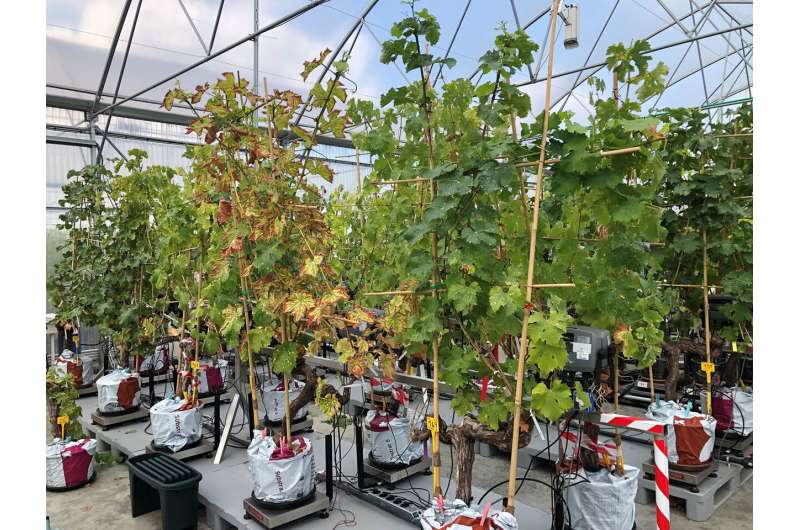Drought curbs a vine disease

Drought and disease are a source of pressure on vines, causing yield loss and mortality in vineyards. But these plant stresses do not necessarily act in synergy. A research team from INRAE, Bordeaux Sciences Agro, the Université de Bordeaux and the Institut Français de la Vigne et du Vin, recently discovered that drought conditions suppress the appearance of esca leaf symptoms, one of the most common grapevine wood diseases. Their results, published on October 21st in PNAS, are a major breakthrough in the understanding of this disease and the complex interactions between plants, pathogens and climate. The continuation of these studies could lead to better prediction of the onset of esca by analyzing the physiological state of the plants and drought data.
Over the past twenty years, a global deterioration has been observed in vineyards. Vine yields and longevity are declining and there is an increase in vine mortality in plots (a production shortfall of 3.4 million hectolitres was estimated across vineyards in France in 2014). It is estimated that dieback due to wood diseases causes the loss of 5% of vineyard surface every year. For a long time, the only cause put forward was vine wood diseases, among which esca is the most prominent. This disease, for which existing treatments do not provide satisfactory control, is caused by parasitic fungi that penetrate the wood of the vine. These pathogens cause necrosis and characteristic symptoms on the leaves (discoloration and necrotic stripes). To explain the mechanisms of this disease, in recent years scientists have put forward the hypothesis of multiple causes linked to pathogens, climate change, farming practices, etc. To better understand the reasons and the complex mechanism leading to this decline, INRAE scientists have studied the interaction of two major factors in vine dieback: esca and drought.
A new experimental approach to study vine esca under drought conditions
The mechanisms underlying esca are poorly understood because it is a difficult disease to study under controlled conditions. Because it only affects vines over seven years old, it can only be observed on plots outdoors. In order to create controlled drought conditions, scientists first developed a method of transplanting vines into pots based on methods used to grow bonsai trees. They transplanted 51 30-year-old Sauvignon blanc vines from the INRAE Grande Ferrade experimental estate near Bordeaux. These vines had already been monitored for esca for six years. Over a two-year period, they monitored the appearance of esca symptoms in a controlled environment for the first time, analyzing with precision the physiological state of the plants, half of which were under drought conditions.
Drought inhibits esca symptoms
One of the hypotheses put forward to explain the increase in vine dieback in recent years was a synergy between environmental factors such as the increased frequency and intensity of droughts and diseases such as esca. This study shows the opposite. No vines under moderate to severe drought conditions showed symptoms of esca on the leaves. Drought inhibited the disease during both of the two seasons studied, demonstrating the central role of vine water status in esca development. The scientists have suggested several explanations for this unexpected result. A water deficit caused by drought could directly inhibit the activity of parasitic fungi; or drought could also affect the plant's defense responses. Another hypothesis is that the strong reduction in water transport in the plant caused by drought would also suppress the transport of toxic molecules produced by the fungi. While the applied drought had a positive effect in suppressing esca symptoms, it is essential to remember that water availability is a major factor in crop productivity and yield loss.
This study is an important stepping stone in understanding esca and the influence of climate on this vine disease. Research will continue with the aim of better understanding the role of climate (rainfall, temperature, etc.) on esca expression on a national scale. In the long term, this research could make it possible to better predict the appearance of esca symptoms by monitoring drought indices and the physiological state of vines in vineyards.
More information: Christophe Riou et al, Action plan against declining vineyards: An innovative approach, BIO Web of Conferences (2016). DOI: 10.1051/bioconf/20160701040
Journal information: Proceedings of the National Academy of Sciences
Provided by INRAE


















